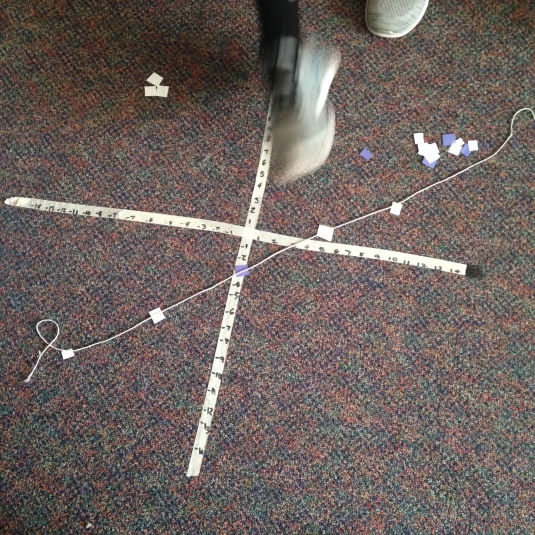We are now into Week 2 of the Blogging Initiative, “My Favorite”! You should definitely check it out if you would like some blogging inspiration! It is only four posts and it’s not too late to join in.
My favorite for the week is Instagram. Instagram is a social network that many of my students use every day. They use it to post pictures, connect and talk with their friends, and follow bands/celebrities. The first thing that my students do when they wake up in the morning is check their Instagram. We live in a world where social networks are a part of our everyday lives. Instead of banning it in schools, why not use it to our advantage.
At the beginning of the year, I created a class Instagram. On the first day, I had any student with an Instagram account follow me at Ms.Finneyfrock . I used my Instagram weekly in my classes and in all different ways.
#MathCrushMonday
When students walk in the door on Mondays, my Instagram is up and ready on the SmartBoard with a mathematician as my latest photo and the hashtag #Mathcrushmonday. Students then get on their phones/computers and start l ooking up facts about the mathematician on my Instagram. Each student then has to comment a different fact on my picture. I am constantly refreshing my Instagram on the SmartBoard so students can see what is being posted. If students don’t have an Instagram account then they work with another student.
ooking up facts about the mathematician on my Instagram. Each student then has to comment a different fact on my picture. I am constantly refreshing my Instagram on the SmartBoard so students can see what is being posted. If students don’t have an Instagram account then they work with another student.
I love #mathcrushmonday because it is a fun and relaxed way to start Monday, and it exposes my students to more than just the curriculum. 5 minutes of class, once a week, allows us to learn about a bunch of mathematicians. Sometimes a real conversation sparks in class when they are researching different mathematicians. I have
 4 classes, so I erase the comments from the class before, so all of my students have the same #mathcrushmonday. My schedule changes every day, so each class has had their comments left up at least once. It’s interesting to see how the facts students find vary by class.
4 classes, so I erase the comments from the class before, so all of my students have the same #mathcrushmonday. My schedule changes every day, so each class has had their comments left up at least once. It’s interesting to see how the facts students find vary by class.
Homework Help
Instagram also offers an awesome direct message feature. Students can send me direct messages to ask about homework, due dates, or pictures if th ey take them in class. I have been able to easily help students with their homework. If they get stuck on a problem, I have had students send me a picture of where they got stuck. I am then able to ask them questions and help them through their assignments. Sending pictures through your phone is much
ey take them in class. I have been able to easily help students with their homework. If they get stuck on a problem, I have had students send me a picture of where they got stuck. I am then able to ask them questions and help them through their assignments. Sending pictures through your phone is much  easier than sending a picture through an email and MUCH faster. I also get notifications if a student messages me right away. I really like direct messaging because it is similar to texting, but my students don’t have my cell phone number. If I don’t want to receive notification for the night or weekend I can just sign off the application.
easier than sending a picture through an email and MUCH faster. I also get notifications if a student messages me right away. I really like direct messaging because it is similar to texting, but my students don’t have my cell phone number. If I don’t want to receive notification for the night or weekend I can just sign off the application.
Classwork
I take pictures of my students in class all the time! Whether they are working on a project, going through stations, working with a partner, or just taking notes! I will take a lot of “in the moment” photos, but students love to pose for the pictures. They know that if they are doing their work I will come and take a picture of them. They always want me to put it “on the gram”. I will also take videos of cool activities we do in class! I can also post these on my Instagram. I typically put my school as the location of the photo. This way the school can see everything I post and if anyone is looking at pictures taken at the school they can see our fun class activities! I also told parents about my Instagram. A lot of parents follow my account. By posting about activities we do in class, parents can see and be involved in what’s going on in my class.
Motivation and Reminders
I will use my Instagram to post reminders about due dates and motivate my students to get through the we ek. One night had students turning in projects via email and knew a lot of them were stressing about it. I took a picture of the few I already received and posted a Pic Stitch of their work with a caption that said “ke
ek. One night had students turning in projects via email and knew a lot of them were stressing about it. I took a picture of the few I already received and posted a Pic Stitch of their work with a caption that said “ke ep up the great work! These are looking great so far!” I will also post funny memes on days that I can see students are struggling.
ep up the great work! These are looking great so far!” I will also post funny memes on days that I can see students are struggling.
Personal Connection
I also use my Instagram to show my students that I am more than just a teacher. Over winter break, I posted a picture of the homemade ravioli my family made and in the caption wrote “I hope you all enjoying your time off!” I also used it to wish my students a Merry Christmas (in equation form of course 🙂 ) Instagram also makes you seem more approachable and relational to your students. I also post pictures from community meetings, sporting events, talent shows ext. to involve the entire community. By using Instagram you can seem more approachable and relational to your students.
I love using Instagram in and out of my classroom. Students already use this app daily, so why not integrate it into your classroom?! If you have any questions let me know!



 ooking up facts about the mathematician on my Instagram. Each student then has to comment a different fact on my picture. I am constantly refreshing my Instagram on the SmartBoard so students can see what is being posted. If students don’t have an Instagram account then they work with another student.
ooking up facts about the mathematician on my Instagram. Each student then has to comment a different fact on my picture. I am constantly refreshing my Instagram on the SmartBoard so students can see what is being posted. If students don’t have an Instagram account then they work with another student. 4 classes, so I erase the comments from the class before, so all of my students have the same #mathcrushmonday. My schedule changes every day, so each class has had their comments left up at least once. It’s interesting to see how the facts students find vary by class.
4 classes, so I erase the comments from the class before, so all of my students have the same #mathcrushmonday. My schedule changes every day, so each class has had their comments left up at least once. It’s interesting to see how the facts students find vary by class. ey take them in class. I have been able to easily help students with their homework. If they get stuck on a problem, I have had students send me a picture of where they got stuck. I am then able to ask them questions and help them through their assignments. Sending pictures through your phone is much
ey take them in class. I have been able to easily help students with their homework. If they get stuck on a problem, I have had students send me a picture of where they got stuck. I am then able to ask them questions and help them through their assignments. Sending pictures through your phone is much  easier than sending a picture through an email and MUCH faster. I also get notifications if a student messages me right away. I really like direct messaging because it is similar to texting, but my students don’t have my cell phone number. If I don’t want to receive notification for the night or weekend I can just sign off the application.
easier than sending a picture through an email and MUCH faster. I also get notifications if a student messages me right away. I really like direct messaging because it is similar to texting, but my students don’t have my cell phone number. If I don’t want to receive notification for the night or weekend I can just sign off the application.



 ek. One night had students turning in projects via email and knew a lot of them were stressing about it. I took a picture of the few I already received and posted a Pic Stitch of their work with a caption that said “ke
ek. One night had students turning in projects via email and knew a lot of them were stressing about it. I took a picture of the few I already received and posted a Pic Stitch of their work with a caption that said “ke ep up the great work! These are looking great so far!” I will also post funny memes on days that I can see students are struggling.
ep up the great work! These are looking great so far!” I will also post funny memes on days that I can see students are struggling.




























 ree. Teachers also have the option of teaching an all day class. I decided to teach an afternoon class called Math goes to the Movies!
ree. Teachers also have the option of teaching an all day class. I decided to teach an afternoon class called Math goes to the Movies! as tricky finding material that all students could do.
as tricky finding material that all students could do.






